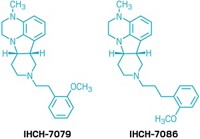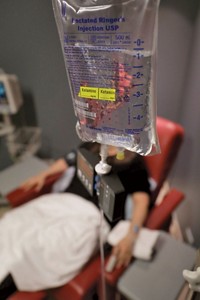Advertisement
Grab your lab coat. Let's get started
Welcome!
Welcome!
Create an account below to get 6 C&EN articles per month, receive newsletters and more - all free.
It seems this is your first time logging in online. Please enter the following information to continue.
As an ACS member you automatically get access to this site. All we need is few more details to create your reading experience.
Not you? Sign in with a different account.
Not you? Sign in with a different account.
ERROR 1
ERROR 1
ERROR 2
ERROR 2
ERROR 2
ERROR 2
ERROR 2
Password and Confirm password must match.
If you have an ACS member number, please enter it here so we can link this account to your membership. (optional)
ERROR 2
ACS values your privacy. By submitting your information, you are gaining access to C&EN and subscribing to our weekly newsletter. We use the information you provide to make your reading experience better, and we will never sell your data to third party members.
Pharmaceuticals
Rethinking Schizophrenia
Advances could spur treatments for more symptoms than current drugs address
by Carmen Drahl
September 15, 2008
| A version of this story appeared in
Volume 86, Issue 37

WHEN ACCOUNTS of schizophrenia began to emerge in the 1800s, institutionalization was the most common treatment for patients suffering from the disease. Despite significant advances in therapy, many of today's patients still find fitting into society a big challenge. Although iconoclastic 1960s psychiatrist Ronald D. Laing once wrote "Schizophrenia cannot be understood without understanding despair," the prevailing sentiment at last month's American Chemical Society national meeting in Philadelphia was one of hope. Researchers have learned more about the pathways that underpin schizophrenia, and those advances have led to drugs in clinical trials that reflect new approaches to treating the disease.
Session organizer John E. Macor, executive director of neuroscience discovery chemistry at Bristol-Myers Squibb (BMS), in Wallingford, Conn., told C&EN that existing medications for schizophrenia, known as antipsychotics, do not remedy all of the disease's symptoms. Speakers at the Division of Medicinal Chemistry-sponsored symposium advocated moving beyond established drugs, which are all aimed at dopamine neurotransmission. They argued that focusing on new targets, such as the glutamate neurotransmitter system, a nicotinic acetylcholine receptor, or a signaling pathway mediated by cyclic nucleotides, might tackle a wider range of symptoms.
In her stage-setting overview for the session, Judith A. Siuciak, principal scientist for neuroscience biology at BMS, characterized schizophrenia by what she described as positive, negative, and cognitive symptoms. Commonly prescribed drugs ease positive symptoms, which include hallucinations and disorganized speech. However, she said, the drugs are less effective at eliminating negative symptoms, such as lack of motivation and inability to experience pleasure, and cognitive symptoms, which include impairments to memory and decision-making.
"The medications that we have are only partially effective," concurs Robert K. Heinssen, deputy director of the National Institute of Mental Health's (NIMH's) Division of Services & Intervention Research, who did not attend the symposium but spoke with C&EN beforehand. What's more, he adds, not all patients respond equally well to the drugs. Even with medication, schizophrenia sufferers can be withdrawn and have trouble processing information, so "these patients are overwhelmed by the competing demands of our environment," he says.
Normalizing glutamate neurotransmission might alleviate some of those symptoms, data from a Phase II clinical trial from Eli Lilly & Co. suggests. Many years of research findings indicate that aberrant glutamate signaling is involved in schizophrenia, James A. Monn, a Lilly research fellow, told symposium attendees.

For instance, activating metabotropic glutamate (mGlu) receptors, which are G-protein-coupled receptors that fine-tune the glutamate signal, can reverse the effects of the street drug phenylcyclohexylpiperidine (PCP) in rats. PCP can induce all three types of schizophrenia symptoms and works by blocking the N-methyl-D-aspartate (NMDA) receptor, an ion channel that responds to glutamate. Lilly set out to develop a drug capable of reversing the effects of PCP on glutamate signaling with the hope that it would work against schizophrenia. They developed LY404039, a selective mGlu2/3 receptor activator that mimics glutamate. The team added a methionine amide to LY404039 to enhance its oral absorption, yielding their drug candidate, LY2140023, a prodrug that is later cleaved to reveal the active drug.
Lilly's Phase II trial brought exciting results. LY2140023 relieved schizophrenia patients' positive and negative symptoms to a greater extent than a placebo. In addition, the compound didn't cause weight gain, a common side effect of several established schizophrenia drugs (Nat. Med. 2007, 13, 1102). The trial results validated the idea that targeting the glutamate system is a legitimate way to treat schizophrenia, Monn said. Lilly is now conducting a larger scale Phase II trial.
Other researchers have studied a more indirect way to target glutamate neurotransmission—blocking a glycine transporter known as GlyT1. Normally, GlyT1 decreases the concentration of glycine in synapses, the interneuron structures through which neurochemical messages propagate from neuron to neuron. Glycine, together with glutamate, is required to activate the NMDA receptor, which mediates glutamate signaling in the brain. A drug that blocks GlyT1 would allow higher concentrations of glycine to remain in the synapse and could aid in normalizing glutamate signaling in patients.
AT THE ACS MEETING, Scott E. Wolkenberg, research fellow in medicinal chemistry at Merck Research Laboratories, in West Point, Pa., described an orally administered GlyT1 blocker, DCCCyB. The researchers optimized a hit from a high-throughput screen to make it selective for GlyT1. Additional modifications prevented the compound from being pumped away from its site of action by the transporter P-glycoprotein and improved the molecule's in vivo pharmacokinetic profile, eventually leading to DCCCyB. Tests in rodents suggested that DCCCyB might treat both cognitive and positive symptoms. Studies with a novel positron emission tomography (PET) tracer (C&EN, Sept. 8, page 13) showed that the drug selectively bound to GlyT1 in rhesus monkeys. These and other results paved the way for a Phase I clinical trial to assess safety and proper dosing for DCCCyB. The trial was recently completed, Wolkenberg reported, but he did not disclose the company's plans.
Also working on GlyT1 blockers, Roderick A. Porter, senior research leader in neurosciences at GlaxoSmithKline, in Harlow, England, described his team's development of a PET tracer that can detect whether GlyT1-targeting drug candidates reach brain tissue efficiently.
Chronicling discovery efforts on other signaling pathways associated with schizophrenia, Patrick R. Verhoest, an associate research fellow at Pfizer, in Groton, Conn., reported on PF-2545920, a compound that inhibits a specific phosphodiesterase enzyme called PDE10A. This enzyme degrades two signaling-related cyclic nucleotides, cAMP and cGMP. PDE10A is preferentially found in the striatum, a portion of the brain that is believed to have impaired regulation in schizophrenia. Blocking PDE10A in rodents that exhibit schizophrenia symptoms has antipsychotic effects and also appears to improve cognitive symptoms, findings that led to intense interest in exploring this approach for schizophrenia treatment.
In order to develop a compound that would be selective for PDE10A over other phosphodiesterases, Verhoest and his colleagues decided on a discovery strategy that would allow them to simultaneously evaluate multiple classes of molecules. The most promising candidate that emerged from this exercise, PF-2545920, hydrogen-bonds to a key tyrosine residue on PDE10A and fills the enzyme's unique hydrophobic pocket, as determined by an X-ray crystal structure. The structure also indicates that PF-2545920 derives added binding affinity by interacting with a water molecule in the pocket where cyclic nucleotides usually bind.
The compound was effective at treating schizophrenia symptoms in animals. Pfizer has completed Phase I clinical trials with PF-2545920, which now has entered into Phase II trials. "We hope this compound will help us determine whether PDE10A inhibitors will be effective against schizophrenia," Verhoest said.
Daniel Yohannes, director of drug discovery at Targacept, gave the last presentation, describing compounds that activate the α7 neuronal nicotinic acetylcholine receptor (NNR). Many schizophrenia sufferers smoke, he said, and it has been shown that the exposure to nicotine improves some of their cognitive symptoms. "Researchers are trying to mimic the effects of nicotine for schizophrenia patients in a much safer way," Macor told C&EN.
Targacept's team explored a variety of bicyclic nitrogen-containing compounds called quinuclidines to find a selective α7 NNR activator. They decided to design molecules with some crucial elements for good binding to α7, including a hydrogen-bonding interaction with a leucine residue that modulates signaling and an interaction with the π electron system of a key tryptophan residue. Their clinical candidate, TC-5619, selectively boosts the activity of α7 and helps animals exhibiting cognitive and positive symptoms. Yohannes did not disclose TC-5619's precise stereochemistry but reported, without offering details, that a Phase I clinical trial to assess its safety and dosing has been completed.
The speakers at the session demonstrated how companies are rapidly shifting to new strategies for treating schizophrenia, Macor told C&EN. "The industry has moved faster than I realized," he said.
But schizophrenia is still largely tackled by treating symptoms because so little is known about what causes the disease. There is considerable room for improvement, NIMH's Heinssen says. "We're still trying to understand the basic mechanisms of schizophrenia, which will hopefully lead to more effective treatments that target core features of the illness," he adds.





Join the conversation
Contact the reporter
Submit a Letter to the Editor for publication
Engage with us on Twitter